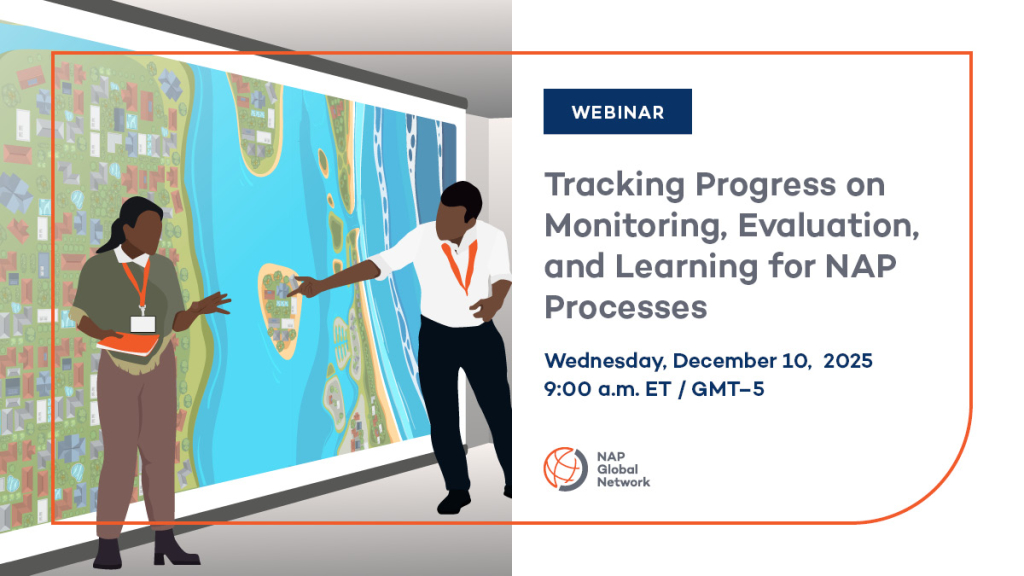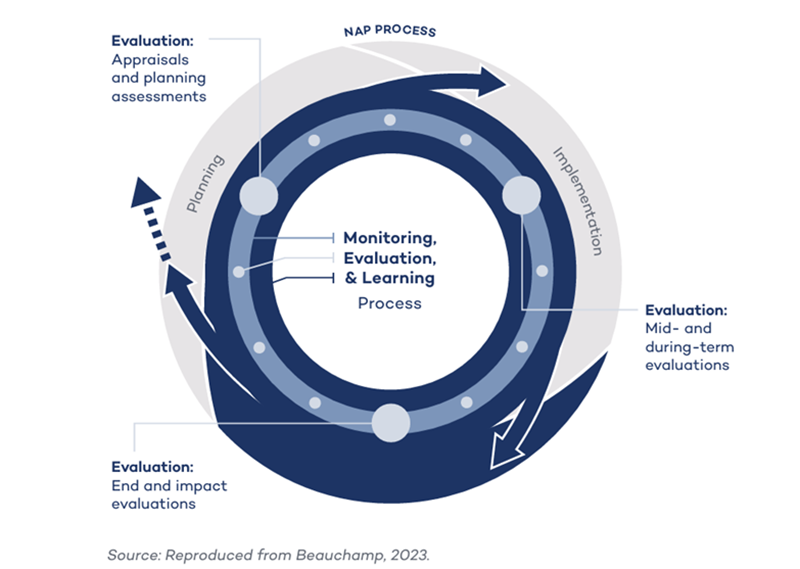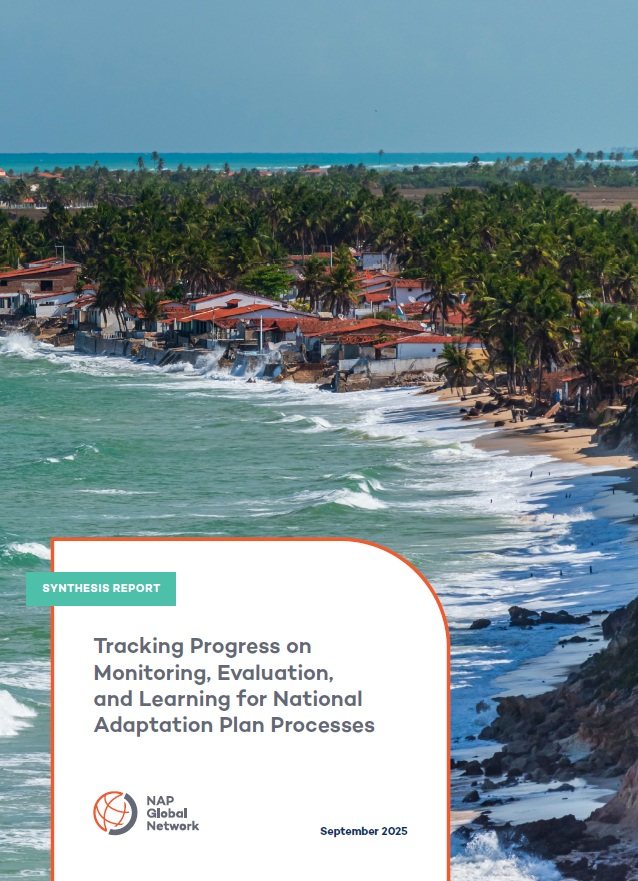
Monitoring, evaluation, and learning (MEL) systems are a core component of both the national adaptation plan (NAP) process and the NAP document. They are designed to assess whether adaptation strategies are achieving their intended outcomes, to understand how and for whom they are effective, and to inform adjustments based on evidence. Essentially, MEL systems generate insights on what works, what does not, and why, helping countries continuously improve their adaptation actions. By doing so, MEL enhances the overall effectiveness of climate resilience efforts and reduces the risk of unintended consequences.
MEL outputs also provide a basis for countries to inform reporting processes under the United Nations Framework Convention on Climate Change (UNFCCC) as part of the NAP process. This includes national communications, like Adaptation Communications and other international frameworks such as the Sustainable Development Goals, Sendai Framework for Disaster Risk Reduction, and the Convention on Biological Diversity.
In addition, MEL systems for NAP processes provide essential data for international climate reporting under the Paris Agreement. They support the tracking of collective progress toward the Global Goal on Adaptation, including through the UAE Framework for Global Climate Resilience and the adaptation components of Biennial Transparency Reports.
MEL outputs can also be leveraged to inform the global stocktake on the methodologies, objectives, indicators, and approaches of measuring progress and identifying gaps in adaptation.
In short, integrating MEL in NAP processes means countries can continuously improve and adjust their climate change adaptation strategies to ensure that adaptation actions are effective and outcomes are equitable.

Recognizing the importance of MEL systems for NAP processes, the NAP Global Network examined 62 multi-sectoral NAP documents submitted to the UNFCCC by developing countries as of June 30, 2025. The analysis provided a snapshot of how countries describe the status and design of their MEL systems across the four phases of the iterative adaptation cycle (IAC):
- Impact, vulnerability, and risk assessments (IVRAs)
- Planning
- Implementation
- MEL
It turns out that although MEL is widely acknowledged across NAP documents, only a few specified a source of dedicated financing, timelines, or roadmaps for its implementation.
What is MEL for NAP processes?
MEL is both a dedicated phase and a continuous, cross-cutting function within NAP processes, underpinning accountability, institutional learning, and adaptive management throughout all stages of the IAC. The components of MEL are as follows:
- Monitoring is the continuous collection and analysis of data to track progress against NAP goals, identify deviations, and support real-time decision making.
- Evaluation occurs at key points to assess performance based on criteria such as relevance, effectiveness, and impact. Evaluations can inform planning, guide course correction, or assess overall success.
- Progress reporting synthesizes monitoring and evaluation findings to assess and communicate progress throughout the NAP process.
- Learning is ongoing, both within and beyond MEL activities. It involves generating and sharing insights to inform adaptation policies and practices, enabling adjustment over time.
Figure 1. MEL in NAP processes

How has MEL been integrated into NAP documents?
All 62 NAP documents reviewed (100%) include MEL considerations, with 89% including a dedicated chapter, section, subsection, or annex on MEL. This demonstrates recognition of MEL as a core component of NAP processes.
MEL in the IVRA Phase
- IVRAs are foundational for effective adaptation planning and implementation. However, only 48% of NAP documents identified linkages between climate risk assessments (CRAs), vulnerability risk assessments (VRAs), or IVRAs and their MEL systems, using CRA/VRA/IVRA outputs as baseline data, contextual inputs, and/or risk-based indicators to inform the MEL process.
MEL in the Planning Phase
- Early integration of MEL enables countries to define coherent results chains, establish measurable targets, and proactively address inclusion considerations within adaptation planning. This is relevant as 52% of NAP documents mention a logic model, whether a theory of change or a logic framework, as part of their NAP process and/or MEL system.
- 66% of NAP documents list specific indicators used (or intended for use) as part of an existing or planned MEL system, across four common types of adaptation indicators (climate parameter, adaptation action, adaptation process, and adaptation results) and formulated at different indicator levels (output, outcome, and impact).
- While MEL offers a valuable opportunity to integrate gender and social inclusion considerations measurably, only 45% of NAP documents report the development or planned development of gender-responsive indicators, and only 29% of NAP documents mention gender-disaggregated indicators.
MEL in the Implementation Phase
- Most NAP documents examined include references to either past, ongoing, or future implementation of their MEL system, with 87% of NAP documents stating that their MEL system is under implementation, already implemented, or planned for future implementation.
- 95% of NAP documents mention data collection, management, and analysis considerations for the MEL system, indicating a strong emphasis on planning to establish the technical foundations necessary for effective monitoring and evaluation.
MEL in the MEL Phase
- While 73% of NAP documents include a general commitment to evaluating adaptation actions or the NAP process, only 8% of NAP documents mention mid-term evaluations, and 7% of NAP documents commit to final or impact evaluations.
- 66% of NAP documents report using or intending to use MEL to track and/or evaluate financial flows or fund efficiency or adaptation expenditures.
While this analysis finds that MEL is widely acknowledged across NAP documents, it also identifies clear needs: to strengthen dedicated financing and teams for MEL planning and implementation; to build more comprehensive indicator frameworks; to fully integrate gender-responsive and socially inclusive elements; and to strengthen commitments to report through UNFCCC instruments.
Next Steps

Looking ahead, countries could be increasingly supported to strengthen institutional arrangements for MEL system design and implementation. This might include
- establishing dedicated MEL units or focal points
- improving cross-sectoral coordination mechanisms
- allocating adequate financial and human resources
- ensuring MEL frameworks are systematically informed by IVRAs, with IVRA outputs helping to establish baselines and guide the formulation of adaptation objectives, targets, and indicators grounded in impacts, vulnerabilities, and risks.
To strengthen effectiveness, countries could also
- place greater emphasis on developing and implementing outcome- and impact-level indicators to complement existing output-level metrics and enable more robust tracking across the results chain.
- strengthen the integration of gender equality and social inclusion into MEL systems, through, for instance, the use of gender-responsive indicators and systematic disaggregation by sex, age, disability, geography, and other relevant dimensions, aligned with inclusive MEL principles.
- develop time-bound MEL implementation plans and roadmaps that could help guide the rollout of MEL systems, including timelines for data collection, analysis, and evaluation cycles.
It would also be highly beneficial if MEL systems were designed to support international reporting obligations under the Enhanced Transparency Framework, such as Adaptation Communications and Biennial Transparency Reports.